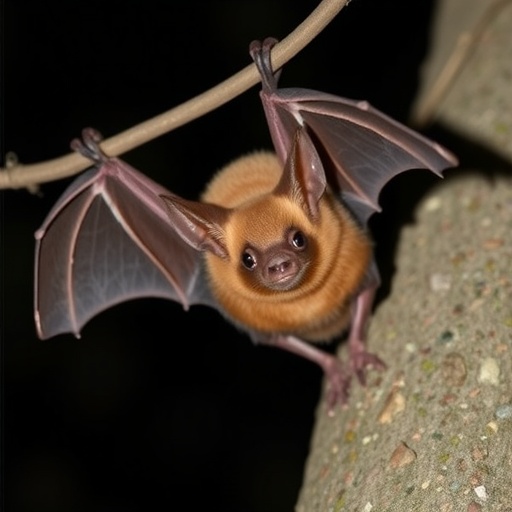In the intricate web of zoonotic diseases, the interface between wildlife and livestock plays a crucial role in the emergence and transmission of viruses. A recent study conducted by an international team of researchers from Italy and the United Kingdom dives deep into one such critical interface: the interaction between bats and pig farms in Northern Italy. This multi-disciplinary research sheds light on the potential spillover pathways of bat coronaviruses to pig populations, illuminating a concerning yet underexplored aspect of viral ecology and public health.
Northern Italy, known for its dense pig farming operations, is also a habitat frequented by at least eight bat species. These nocturnal mammals, renowned reservoirs of various coronaviruses, routinely commute and forage over pig farms, creating a natural intersection that has profound implications for viral spillover risks. The researchers meticulously mapped these interactions and assessed the environmental and farming conditions that facilitate contact between bats, their excreta, and pigs.
One of the alarming findings of the study is the prevalent absence of physical barriers or effective biosecurity measures in many pig farms. This lack of containment allows bat feces and potentially infectious material to come into direct contact with pigs. Given the diversity of coronaviruses harbored by bats, this interface becomes a high-risk hotspot for viral transmission, potentially enabling cross-species infection and genetic recombination, which could result in novel viral strains.
The research employed a range of techniques, blending ecological field surveys, virological analyses, and spatial modeling. By using this multidisciplinary approach, the team was able to identify specific farm characteristics and landscape features that increase the likelihood of bat-pig interactions. Such integrated methodologies are key to understanding the dynamics of viral spillover in complex ecosystems and are exemplary for similar studies worldwide.
Moreover, genomic analyses of bat coronaviruses collected from the area reveal a rich viral diversity, with several strains closely related to known pathogens. These findings underscore the bats’ role as an important viral reservoir and highlight the potential for these viruses to adapt to new hosts. The close proximity of pigs to these reservoirs amplifies concerns about the emergence of novel coronaviruses with zoonotic potential.
The study also highlights gaps in current biosecurity protocols on pig farms in Northern Italy. Many farms lack physical barriers such as netting or covered enclosures that could prevent bats from accessing pig housing or feed areas. Additionally, the management of farm waste and water sources, which can become contaminated with bat excreta, needs urgent attention to mitigate viral transmission risks.
Understanding the behavioral ecology of bats over these agricultural landscapes adds another layer of insight. The researchers observed that bat foraging behavior often coincides temporally and spatially with key periods in pig farming, such as feeding and cleaning times. This synchrony may inadvertently increase contact rates between bats and pigs, creating windows of heightened spillover risk that demand targeted intervention measures.
The study’s findings carry significant implications for both animal health and public health arenas. Pigs serve as important amplifying hosts for several zoonotic viruses, including coronaviruses, enabling viral adaptation and sometimes facilitating transmission to humans. Identifying and mitigating the risk points at the wildlife-livestock interface is therefore critical to preempting future outbreaks.
Crucially, this research is steered by a framework advocating for One Health approaches — recognizing the interconnected health of humans, animals, and ecosystems. Collaborative efforts spanning veterinary science, virology, ecology, and farming practices are indispensable to designing effective surveillance and control strategies that can curtail viral spillover before it escalates.
Funding from the First International ICRAD call under grant agreement No. 862605, ConVErgence ID 95, supported this undertaking, reflecting the global commitment to understanding and combating emerging infectious diseases. The research, published in PLOS One, is a vital contribution to the growing body of knowledge on how human agricultural practices and natural wildlife behaviors converge to shape the landscape of viral threats.
While the study is geographically focused on Northern Italy, the implications are far-reaching. Similar conditions exist globally wherever pig farming overlaps with bat habitats, making this research a foundational reference for international biosecurity policymaking and pandemic preparedness frameworks. It challenges stakeholders to rethink agricultural biosecurity in the context of ecological realities.
Looking ahead, the researchers call for enhanced surveillance systems incorporating environmental sampling and pathogen detection across wildlife and livestock populations. Education and extension services tailored to farmers can promote biosecurity upgrades that reduce bat access without adversely affecting bat conservation, striking a delicate balance between ecological stewardship and disease risk management.
The convergence of wildlife ecology and livestock farming at the heart of viral spillover interfaces demands continuous vigilance, interdisciplinary research, and proactive management. This comprehensive study paves the way for novel strategies to anticipate and prevent zoonotic spillovers, reinforcing the imperative to safeguard both animal and human health in an era increasingly defined by emerging infectious diseases.
Subject of Research: Viral spillover risks at the bat-pig interface on Northern Italian farms with focus on coronaviruses
Article Title: A multi-disciplinary approach to identify spillover interfaces of bat coronaviruses to pig farms in Italy
News Publication Date: 15-Oct-2025
Web References:
10.1371/journal.pone.0332117
Image Credits: Francesca Festa/IZSVE, CC-BY 4.0
Keywords:
Zoonotic spillover, bat coronaviruses, pig farms, Northern Italy, viral ecology, biosecurity, One Health, viral diversity, viral transmission, wildlife-livestock interface
Tags: bat coronaviruses in Northern Italybat foraging behavior near livestockbat species and pig farming interactionsecological implications of bat interactionsinfectious disease emergence in farming systemsmulti-disciplinary research on zoonotic diseasesNorthern Italy pig farming practicespig farm biosecurity measuresviral spillover pathwayswildlife and livestock interfacezoonotic disease risks in agriculturezoonotic disease transmission





